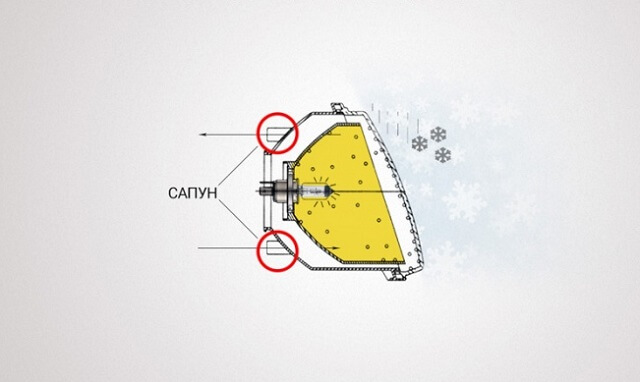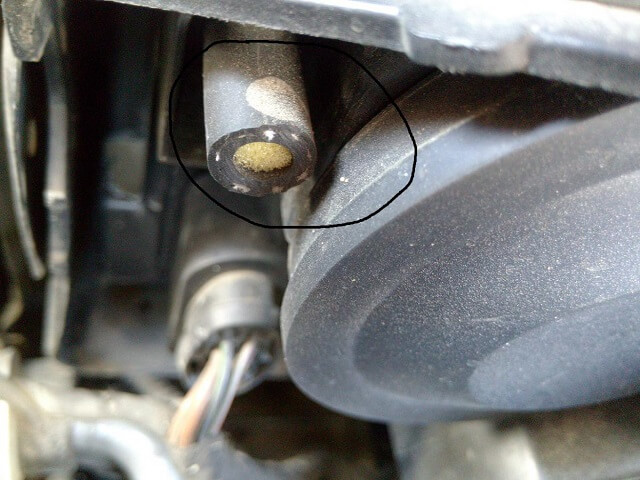Why do car headlights from within and what to do with it?
Optics service is a prerequisite, which is required from each driver. Security depends on the status of optics while driving in the dark. Therefore, it is very important to constantly monitor its health and in time to troubleshoot. However, in addition to blown lamps, cracks, torn wires and other troubles, the headlights may become a serious problem. About why the headlights of the car from the inside sweat, and how to cope with it, it will be discussed in this article.
 Front head fogging
Front head fogging Physical roots of the phenomenon
Before talking about how to eliminate headlights in the car, let's look at the nature of this phenomenon in terms of physics. This will help us understand what measures are needed to solve the problem of fading headlights.
From the course of high school physics, it is known that air contains water particles - their ratio to other components is greater or less, it depends on the level of humidity. The vapor state of water particles is due to their temperature - when heated water goes into a gaseous state. In the process of cooling the steam, it turns into a state of fluid and condensed into water drops.
Inside the optics, the temperature is sufficiently high, but the outer surface of the glass on contact with cold air has a lower temperature - it leads to the fact that moisture drops are condensed on it, and the headlights are condensed.
The design of the lanterns on the car is arranged in such a way as to take into account the fogging of the headlights - there are special ventilation holes. They have special valves that serve to circulate air, at the same time protecting the inner space from moisture and fogging. However, despite this, you can see that even the rear headlight or the front headlights sweat on the new car - then you need to figure out what causes the cause of fogging.
 Air flow diagram in the spotlight
Air flow diagram in the spotlight The reasons are the optics sweat
If the headlight sweats - what to do? To answer this question, it is necessary to carry out a detailed inspection of optics - this will help to identify what cause is the cause of fogging, and take the necessary measures. Below we give a list of basic phenomena that may cause headlights:
- The lamp tightness is impaired - check the joints and sealing of rubber. They can be impaired, which leads to moisture particles inward. Swimmed rubber seals and produced sealant can pass water during car wash, etc.
- The presence of cracks on the surface of the glass or in the lantern housing can also lead to the fact that the inner side of the lantern is constantly filled with moisture.
- The clogging of the ventilation channel by which the air circulation is carried out inside the optics. When the temperature is raised inside the air expands and exits outside, when cooled, it is compressed and sucking inside. Violation of this process can also cause headlights.
If the headlights are sweat on the new car, the reason may be in the factory marriage - the manufacturer could make them not suitable enough. In this case, inspect the rubber seals, seals sealed with sealant, and make sure that there are no cracks and other factory defects on the housing.
If the lanterns dove not on the new machine, the problem may be that the channels for air circulation clogged - this happens quite often. Sometimes it may be a consequence of a recent accident - cracked in the housing and other breakdowns that disturb the tightness of the structure appear. In this case, you need to identify them and eliminate - if the repair is not possible, you will need to replace the lantern.
 With the help of silica gel you can get rid of condensate in the headlights
With the help of silica gel you can get rid of condensate in the headlights Condensate Control Methods
So, after you find out where the headlight sweats, what to do? Below we give a few tips that will help eliminate the sovereign problem. First you should get rid of condensate - take care to carefully dry the inspections of the lantern. If we are talking about halogen optics, it will be enough for some time to turn it on - high temperature eliminate condensate and dry all surfaces. However, xenon and LED lights are practically not heated in the on state - this method is not suitable with them. Then you have to disassemble the lantern and dry it from the inside with a construction hairdryer. To do this, heat the seams, carefully remove the sealant and disperse the case with a screwdriver. Now you can start working with a hairdryer - note that all surfaces are perfectly dry.
Some drivers to remove excess moisture use packages with silica gel - you often meet them in new shoes. These are special granules that absorb moisture, leaving the space around dry. It can be successfully used, especially in cases where the rear headlight sweats. However, you can hear the view that the swelling of the silica gel can lead to damage to the optics design, therefore, especially cautious motorists recommend them only as a temporary measure.
If you are sweating the rear headlight or optics from the front due to cracks in the case - take care of getting rid of it. The glue or tape in this case will not help solve the problem - the crack in the plastic needs to be sought. For this purpose, use a special soldering iron. If you do not have the skills to handle such a tool, you will have to contact the specialists.
 To eliminate the possibility of fogging, it is necessary to improve air circulation in the headlights.
To eliminate the possibility of fogging, it is necessary to improve air circulation in the headlights. If condensate problems on optics lies in clogging the ventilation channel - take care to clean it. For this purpose, dismantle the flashlight, disassemble it and find the channel - usually it is located in the rear. Clean it and install the rubber plug, it will need to competently fix it so that the air can fully circulate. If the problem lies in the fact that the sealant at the joints came into disrepair, act as follows:
- remove the lantern;
- remove the old sealant - use chemical activators for full deletion;
- spend careful degreasing;
- collect the lantern and handle the joints with a new sealant, avoiding it from entering the lamp, glass, reflector, etc.;
- lose day so that the sealant froze well, then install the device in place.
What is dangerous condensate in optics?
Beginner drivers sometimes ask questions: What is the condensate inside the optics? Isn't it easier to do nothing or, simply say "score"? It turns out that the "score" is not worthwhile - droplets of moisture inside the lanterns on your car can be a source of serious troubles:

The list brightly illustrates that take timely measures to eliminate the condensate problem much more profitable than not to pay attention. Ignoring fogging can cause a serious accident or source of unplanned financial expenses.
Conclusion
The appearance of condensate inside optics is a common and familiar phenomenon for many drivers. It can manifest themselves with humidity drops, after washing the machine, etc. Many drivers do not pay attention to this phenomenon, without suspecting that it is fraught with serious trouble. The appearance of moisture droplets on the inner surface of the glass indicates that the tightness of the lantern is impaired or the air circulation problems.
To get rid of condensate, follow three conditions:










